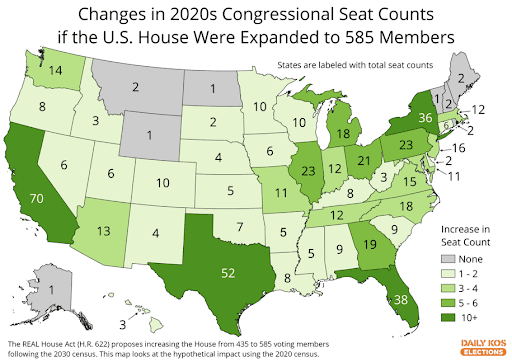|
John,
In 1912, Congress capped the number of Representatives in the House at 435. Since then, the US population has doubled, then doubled again.
As the number of citizens represented by each member grows and grows, your ability to have your own voice heard shrinks. Further, as states have grown in diversity as well as numbers, this diversity is underrepresented as well.
How many constituents does each Congressperson represent? When the House was frozen in 1912, each member served an average of 210,000 citizens. Today this number has ballooned to 761,000, and it could well become over 1 million citizens per member in the coming years.
A bigger House would be a more diverse House. It would result in a higher proportion of districts representing communities of color and other local concerns, which would impact how Congress addresses issues such as jobs, housing, and immigration.
Rep. Earl Blumenauer (D-Oregon) has introduced the REAL House Act to help correct these discrepancies. This legislation would increase the House of Representatives to 585 after the 2030 U.S. Census, improving members’ responsiveness to their communities.
What might this expanded House look like? Daily KOS has prepared this hypothetical map to illustrate how 585 members would be distributed based on 2020 Census data. New York, Texas, Florida, and California would see the largest increases in representation, gaining 10 or more Representatives each.

Expanding the size of Congress has additional benefits. Not only will it increase the proportion of districts where voters of color can select candidates who reflect the community’s concerns, it will also result in greater parity in the population size of each district. Currently the largest districts have nearly twice the population of the smallest.
Reducing the size of districts would improve constituent services by increasing citizens’ access to their lawmakers. It would also reduce campaign costs for each candidate, so they can spend less time raising money and more time attending to their constituents.
Researchers have noted that the U.S. has a much larger ratio of constituents to representatives than other advanced democracies. Following the international formula would result in a House of about 690 seats. Rep. Blumenauer explains that he arrived at his smaller number of 585 by adding 150, which is the number of seats that have changed between states since 1912 plus one to keep an odd number.
Join us in sending our message to Congress: A larger House chamber would more equitably represent its constitutional mandate, by making members of Congress closer to the people. Please pass the REAL House Act to increase the number of U.S. representatives to 585 after the next U.S. Census.
Thank you for doing your part to help create more equitable representation in Congress.
- Amanda
Amanda Ford, Director
Democracy for America
Advocacy Fund
|